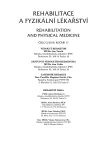Assessment of Muscle Activation Patterns during Gait with Below-knee Prosthesis – Differences between Classic and Dynamic Foot
Authors:
A. Zaatar 1; J. Opavský 1; P. Uhlíř 1; Marika Bajerová 1; M. Janura 2; M. Elfmark 2
Authors‘ workplace:
Katedra fyzioterapie, Fakulta tělesná kultury UP, Olomouc
1; Katedra biomechaniky a technické kybernetiky, Fakulta tělesná kultury UP, Olomouc
2
Published in:
Rehabil. fyz. Lék., 17, 2010, No. 2, pp. 51-56.
Category:
Original Papers
Overview
The aim of this study was to reveal muscle activation patterns on side of the lower limb with amputation and on opposite side, and to compare findings obtained by surface polyelectromyography (poly-EMG) in eleven subjects after transtibial amputation. Muscle activation was registered in every subject during walking with the use of two types of prosthetic foot (classic and dynamic). A registration of muscle activation was performed by means of 8-channel surface polyelectromyography at the subject’s natural pace and at a speed of 52 strides per min during walking on a carpet with contact sensors. Surface electrodes were placed on both sides above four muscles (vastus medialis, biceps femoris, gluteus maximus and erector spinae muscles) and their bioelectric activity was registered. Surface poly-EMG revealed that the first activated muscle was the biceps femoris muscle at the moment of heel strike and at the moment of toe-off, when both types of prostheses were used. Variable sequence of muscle activation was registered for three other muscles. The measurement of the muscle activation showed that the index “area” and index “mean” reached higher values in subjects with dynamic foot. It was found that the muscle activation patterns of the lower limb with below-knee prosthesis with the classic foot differed from ones obtained during walking with the dynamic foot.
Key words:
gait, polyelectromyography, transtibial amputation, below-knee prosthesis, classic foot, dynamic foot
Sources
1. CULHAM, E. G., PEAT, M., NEWELL, E.: Below-knee amputation: a comparison of the effect of the SACH foot and single axis foot on electromyographic patterns during locomotion. Prosthetics and Orthotics International, 10, 1986, s. 15-22.
2. HOF, A. L., ELZINGA, H., GRIMMIUS, W., HALBERTSMA, J. P. K.: Speed dependence of averaged EMG profiles in walking. Gait and Posture, 16, 2002, s. 78-86.
3. Chodidla. In: ING. Life is emotion. Retrieved 10. 12. 2009 from the World Wide Web:
http://www.ingcorporation.cz/cs/dily-protez/chodidla/index.php.
4. ISAKOV, E., BURGER, H., KRAJNIK, J., GREGORIC, M., MARINCEK, C.: Knee muscle activity during ambulation of trans-tibial amputees. Journal of Rehabilitation Medicine, 33, 2001, s. 196-199.
5. KÁLAL, J. K.: K současným problémům lokomoce amputovaných na dolní končetině. Rehabilitácia, 42, 2005, s. 20-29.
6. PINZUR, M. S., ASSELMEIER, M., SMITH, D.: Dynamic electromyography in active and limited walking below-knee amputees. Orthopedics, 14, 1991, s. 535-538.
7. RODOVÁ, D.: Hodnocení činnosti kosterního svalstva povrchovou elektromyografií. Dizertační práce, Univerzita Palackého, Fakulta tělesné kultury, Olomouc, 2002.
8. TORBURN, L., PERRY, J, AYYAPPA, E., SHANFIELD, S. L.: Below-knee amputee gait with dynamic elastic response prosthetic feet: A pilot study. Journal of Rehabilitation Research and Development, 27, 1990, s. 369-384.
Labels
Physiotherapist, university degree Rehabilitation Sports medicineArticle was published in
Rehabilitation & Physical Medicine

2010 Issue 2
Most read in this issue
- Hallux Valgus from the Physiotherapist Standpoint or Is Hallux Valgus Just a Hallux Deformity?
- Evaluation of Motoric Defects in Childhood
- Effects of Treatment with Biosynchron 500 on Motor a Non-motor Symptoms in Patients with Parkinson Disease – Results of a Randomized Study
- Organization of Rehabilitation with Use of ICF (International Classification of Functioning, Disability and Health WHO), Assessment of Degrees of Disability According to Qualifiers)
